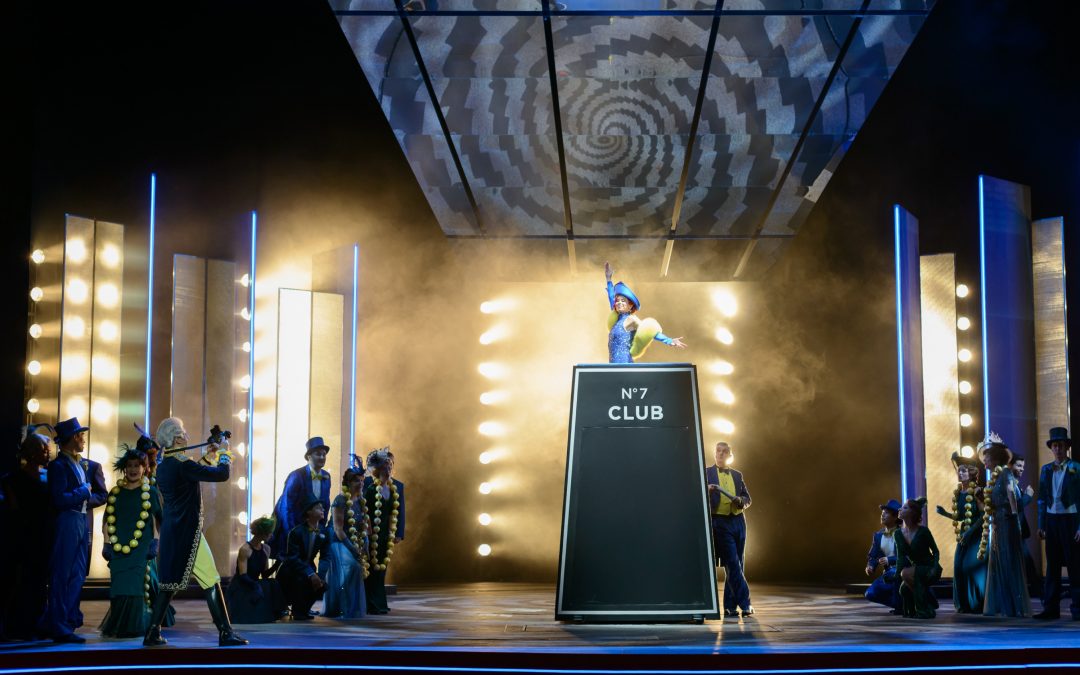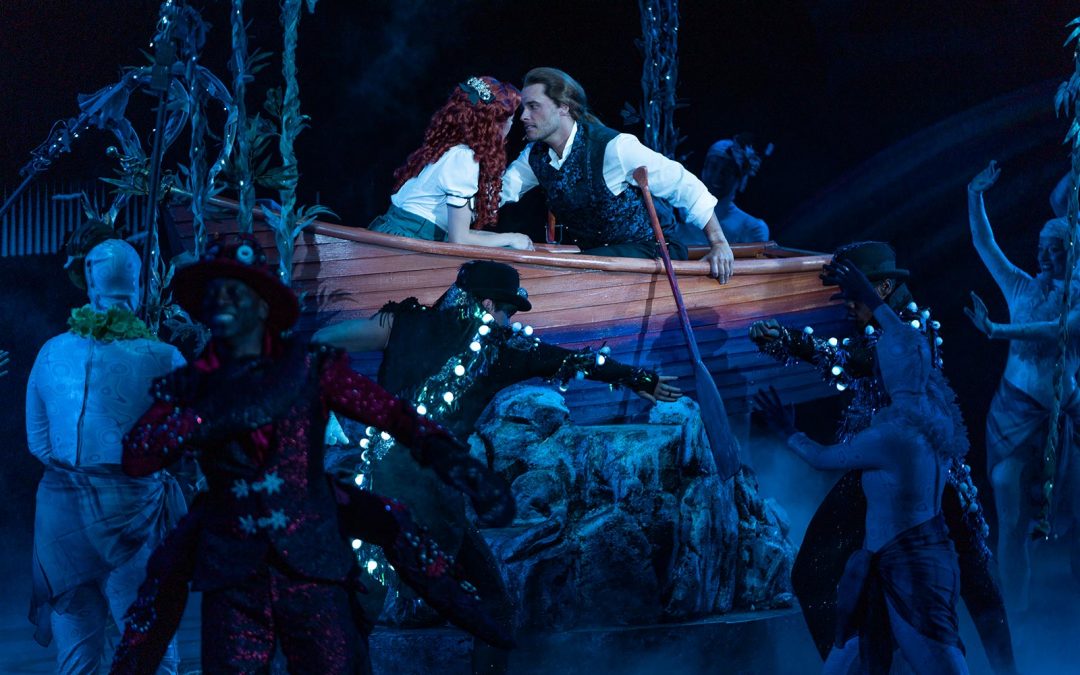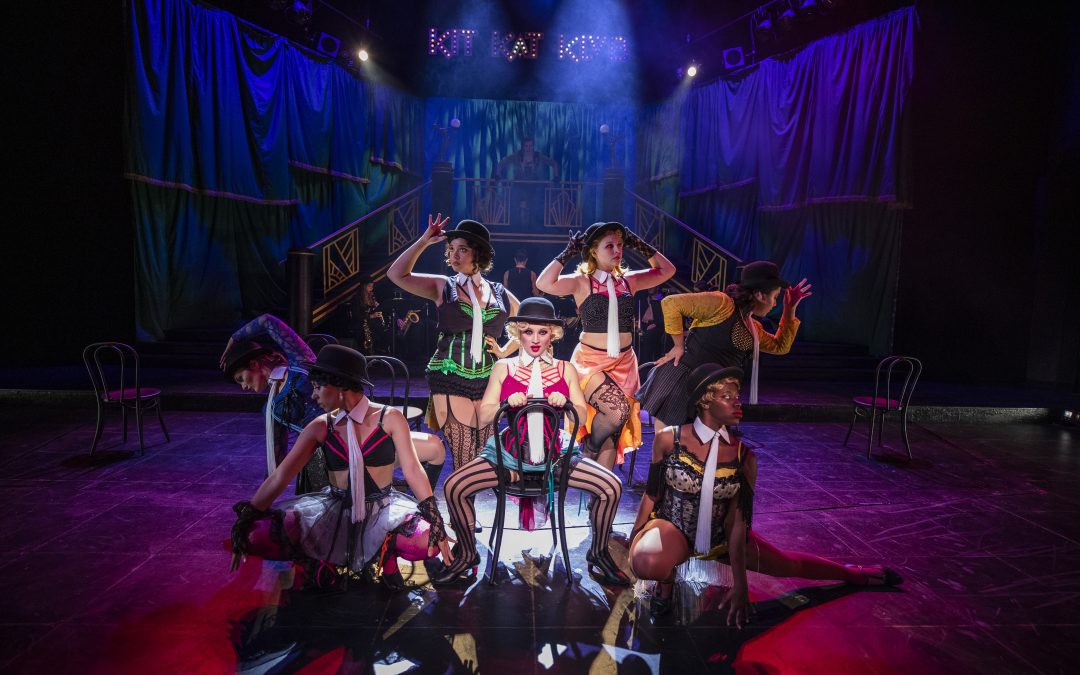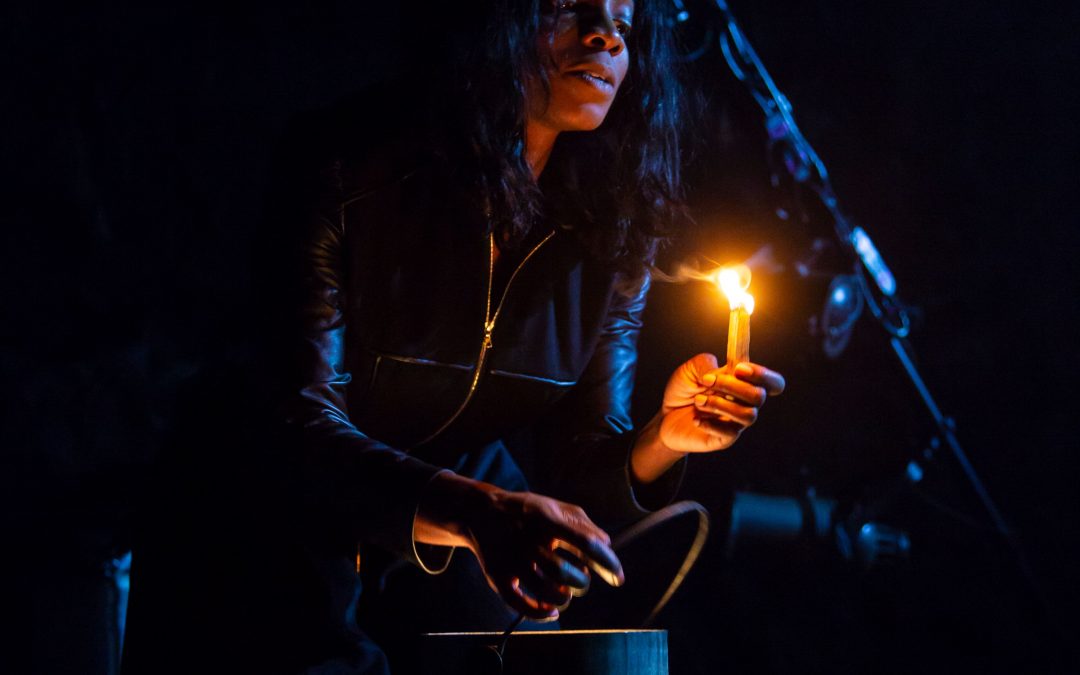
by Aimee Wilson | Jun 28, 2022
Volksoper Wien (Vienna People’s Opera) is a historic opera house built in 1898 and is home to a variety of operas, operettas, ballets and musicals. Earlier this year, they performed the Kurt Weill classic Lady in the Dark. The musical tells the story of Liza Elliott, the editor of Allure magazine and her psychological issue with indecision. She is torn – not between two lovers, but three – all of which want to marry her. For a solution, Liza starts treatment with Dr. Brooks, a psychoanalyst, and they work through her issues by analyzing her dreams. “The set design relied on four wagons equipped with rotating L-shaped walls; they were up to 6 meters high; they created, widened and modulated the space,” notes lighting and networking engineer Christian Allabauer of Volksoper Wien GmbH. Lady in the Dark opened there in late 2021; the lighting design for Lady in the Dark was done by Michael Grundner.
Liz’s dreams take center stage during the performance; one dream takes place in a glamour setting, another is during a wedding, and the third takes place at a circus that includes a trial. “The transition along the glamour, wedding and circus dreams were pronounced by color-tunable LED tubes, fitted along the edges of the walls. Six wheeled archways were equipped with blue LED tubes, opening the world to the ‘blue dream,’ and supporting its choreography,” Allabauer adds.
Due to the nature of the scenic wagons, Volksoper required a wireless solution for the LED tubes. “To achieve the required flexibility, wireless control was a must-have,” he admits. “The compact design required metal framework; there was a lot of traffic on stage, and little space to fit electronics made us consider the locations of receivers very carefully.”
To control the LED tubes, Volksoper Wien turned to RC4 Wireless. “’Lady in the Dark’ was our first production running RC4; we appreciate the small form factor combined with a high-power rating,” he notes.
The RC4 Wireless W-DIM4 four-channel wireless high-power dimmer was Volksoper’s choice for Lady in the Dark. “The W-DIM4 became one of our most frequently used tools, as wireless stage lighting elements are requested again and again by leading teams. Fifteen amps per channel in such a small housing is amazing!” says the lighting and network engineer.
In terms of programming the W-DIM4, he says, “It’s very easy and intuitive! Dimming curves and the capability to dim tungsten lamps as well are quite helpful.” For RC4 Wireless users in Europe, he adds, “You need to get a special tool to crimp the connectors; Anderson connectors are not easy to find in Europe. Order some additional connectors to use the units for several productions.”
RC4 Wireless also provides customer service via phone and email which Allabauer utilized during the production. “We really appreciated the great and instant service,” he says.
Lady in the Dark concluded its run in early 2022. Their 2022/2023 season includes La Cage aux Folles, Into the Woods, and the ballet Begegnungen; Volksoper is using the W-DIM4 in the second act of the ballet. RC4 Wireless technology is also part of Death in Venice, a co-production with the Royal Opera House Covent Garden. Allabauer concludes, “The RC4 W-DIM4s just worked reliably and were an important factor in getting the job done.”

by Aimee Wilson | Jun 2, 2022
At RC4 Wireless, every project starts with a customer’s captivating idea. Back in 2014, that call came from Ciro Scotto d’Antuono from Strictly FX, who had been commissioned to build a series of wirelessly controlled lanterns for World Wrestling Entertainment (WWE). WWE character Bray Wyatt carries what appears to be an antique gas lantern onto the stage in every performance. Ciro was in the process of building a new brighter lantern with a built-in Look Solution Tiny Fogger, all controlled from the show’s primary DMX console.
Strictly FX has used RC4Magic dimmers many times in the past and trusted them for this high-profile job. In this application there was very little space for the fogger, battery, and wireless dimming technology — a perfect job for the miniature RC4Magic Series 3 DMX2micro. The Series 3 DMX2micro is full featured, just like all the other Series 3 versatile wireless dimmers from RC4, and measures only 71mm x 18.8mm x 11mm. It is the smallest wireless DMX receiver and dimmer in the world, perfect for this application.
WWE tours the world, performing in a different location every night. RC4Magic unique digital IDs ensure that whatever arena they are located in, they never have to worry about interference from any other RC4Magic system.
“When I see Bray Wyatt walk into the arena holding that lantern, then watch him make his way to the center and into the ring while it is glowing and emitting smoke that is controlled from the front of house, I feel great knowing we have helped WWE and Strictly FX Live Life Untethered,” says Sean Dane, RC4 Wireless Application Specialist.

by boss | Mar 31, 2020
In the year 1836, the magical story of a mermaid and a king leapt out of the imagination of Hans Christian Anderson and became the beloved tale of “The Little Mermaid”. In the 150 plus years since then, the iconic, magical story – with the help of two Disney films – has become something of a phenomenon.
When the Tuacahn Center for the Arts, based in Ivins, Utah, decided to present their take on this theatrical classic, they turned to RC4 Wireless to create some magic all over the stage, which include costumes, set pieces and even props. “For pixel control of the Flotsam and Jetsam costumes we used a DMXpix — one for each piece. We used them with pixel domes, which are individually controllable pixels, but spaced out and capped with a plastic ‘dome’ to diffuse the light,” explains Adam Manning, Assistant Master Electrician at the Tuacahn. Manning wasn’t working alone on the project; the team also included Lighting Designer Nick Van Houten of NVH Design, Costume Designer Dustin Cross and Scenic Designer Adam Koch.
The illuminated costumes of Flotsam and Jetsam weren’t the only pieces using the DMXpix. It was also used in King Triton’s trident. Manning notes: “The DMXpix inside the trident provided approximately 4.5A – or 22.5W – for the pixel tape.” The DMXpix is a pixel driver that can control a large number of pixels without a media server, and was the winner of a PLASA Award for Innovation when it was introduced. “The principle of the DMXpix is to move pattern repetition out of the lighting console and over to the pixel controller. The look of the pattern, what we call the Keyframe, is created on the console using a select number of channels, then the DMXpix does the job of replicating that pattern in a variety of user-configurable ways to control up to 500 pixels,” explains James David Smith, Founder and Chief Product Designer at RC4. “And, a single DMXpix can do all of that twice — it’s actually two drivers in one, each with its own Keyframe.” The RC4Magic DMXpix is available in the popular 2.4GHz range for use worldwide and in the much less congested 902-928MHz band in the US, Canada, Australia, and New Zealand.
In terms of The Little Mermaid set, there was wirelessly controlled lighting in nine set pieces including “Two castle towers, Ursula’s shell, two King Triton towers and Ursula’s cauldron,” explains Manning. In terms of gear, “We used an RC4 MagicDMX4dim for each set piece to drive the LEDs on each unit,” explains Manning. The RC4 Wireless DMX4dim is one of the firm’s most popular products; it’s also the wireless workhorse at the Tuacahn. “We use the DMX4dim for everything,” states Craig Engel, production manager at the Tuacahn. The DMX4dim is a 4-channel dimmer, also available in both 2.4GHz and 900MHz, and works with an RC4 DMXio Transceiver to control lighting—as well as servo motors, and much more—wirelessly. Manning continues: “For me, using the system to create magical wireless effects has been the go-to. The setup of the system is very simple and doesn’t take very long to do. Once the system is set up, it doesn’t take much to keep it working.” The system can be set-up manually with buttons and indicators on each unit or via RC4 Commander Configuration Software. “One thing I’m super proud of is that our new Commander software is backward compatible with most of our Series 2 devices, so it works with a mix of devices going all the way back to 2011. It is Series, Model, and firmware-version aware, so what you see is accurately what you get when viewing and setting parameters on screen,” explains Smith.
As with all wireless units, placement is key. “We build our set pieces with a steel frame, so keeping a clear line-of-sight from the transmitters to the receivers is critical for consistent operation. As long as the units are enclosed in a material which is transparent to radio waves, keeping a clear connection isn’t an issue,” says Manning.
Manning has been working with RC4 Wireless equipment for the past three years. “Once the system is set up, it just works. Of course, I do have to make the rare call for troubleshooting help. When I have called customer support, they have been very helpful at providing quick and effective solutions. They are very knowledgeable about the hardware and can provide answers to any questions quickly,” says Manning.
Engel has been working with RC4 gear even longer. “I have been associated with the theater for 10 years and RC4 has been the wireless system in use. They have the absolute best customer support bar none of any vendor I deal with and their equipment is super reliable and innovative,” Engel concludes.

by boss | Feb 22, 2020
Cabaret has been a favorite on the stage – and on screen – since it debuted in 1966. When Theatre UNI brought Cabaret to their stage at the University of Northern Iowa, they turned to gear from RC4 Wireless to help them achieve their vision. “I had used RC4 products on a handful of shows in the last 3 years and each of those experiences had gone incredibly smoothly,” states Cabaret’s Assistant Lighting Designer, Devin Schupp.
The production required a plethora of wireless gear. Schupp continues: “We had a few different set pieces which contained a practical light fixture on them – this included two Kit Kat Klub tables each having a small table lamp in the center, a floor lamp for the interior of a boarding house, and a cue light that was part of a dressing room mirror for a Klub performer. All of these items were constructed with some variation of either 12V LED tape or individual diodes. Each of these set pieces was carried or rolled on and off the stage for particular scenes. Due to the desired fast pace of scene changes, and the huge amount of dancing in the show, it would not be very practical at all to have these as hard-wired pieces.”
The lamps and mirror lights were fairly straightforward in terms of wireless dimming and DMX. However, there were other show requirements that weren’t quite so simple. “We decided to construct three large ‘Kit Kat Klub’ signs; one for the stage, and one for each end of the building’s lobby. These signs consisted of individual LED pixels spaced out through the letters, similar to a marquee style. We wanted individual pixel control and the ability to play selected media content on the signs. Due to the layout of the facility, the two lobby signs had to receive data from the console wirelessly; there simply was no other option. Additionally, the wireless signal to the lobby would have to pass through tons of concrete and steel in order to get through the walls and to the lobby.”
For the lamps and mirror lights, the team, led by Lighting Designer Chris Wood, used RC4 Wireless 2.4GHz products, including a DMX2dim, DMX4dim, DMX4dim-500, DMX6dim with a 2.4GHz transceiver. However, for the signs located in the lobby that had to transmit through concrete and steel, the team used RC4’s 900MHz DMXio transceiver with a 900MHz DMXpix. “The 900MHz equipment made it possible to transmit through the walls and out to the lobby. Everyone on our team was thoroughly impressed with the 900MHz range of products. We were transmitting moving media content through an incredible amount of concrete and steel, and these products handled it with no lag or problems at all,” Schupp explains.
In terms of programming the furniture items, “The process was an incredibly simple ‘plug and play’ situation. The RC4 receiver was connected to the power source and the light fixture and patched into the console and written into the cues just like any other standard dimmer. No additional configuration of the receivers was required,” says the Assistant Lighting Designer.
For the Kit Kat signs, “Programming was a little more of an involved process, but very quick to pick up on. Due to a limitation of available DMX addresses, we were not able to give a unique address to every pixel in both of the lobby signs. The DMXpix has the ability to keyframe the output, which essentially repeats the address values after a certain number. For these signs, ‘pixel #1’ would be both the first pixel in the chain, as well as the next one after the midpoint. This allowed the signs to only require half the amount of DMX addresses, giving us the ability to fit both signs into the same DMX universe. The RC4 Commander software makes this process incredibly easy to figure out and fine tune to your specific needs,” Schupp explains.
The entire Cabaret team worked with the RC4 equipment on site. “Shawn Poellet [Master Electrician], Nate Brock [Asst. Master Electrician], and Alex Drelich [Asst. Master Electrician] worked together to add the lighting components to the furniture pieces, build the Klub signs, and wire all of the RC4 gear into everything,” comments Schupp.
Overall, Schupp has had positive experiences with RC4 wireless products. He explains: “Every time I have used an RC4 product, I’ve been incredibly pleased with the results; RC4 products are made for anyone. If someone simply needs a wireless dimmer — say for a handheld lantern — they just need to plug everything in, and they’re all set to go; no additional configuration is required. Opposingly, if someone needs a wireless pixel driver and has restrictions that may require advanced configuration of the receiver, those advanced capabilities are present and can be configured in a user-friendly manner.”
Schupp concludes: “RC4 products are easy to incorporate into numerous projects that can add pleasing details to any production. It is incredibly easy to get started with, and also allows for some more complex configurations for those who need it.”

by boss | Nov 7, 2019
‘The Iliad’ is an epic piece of classical poetry and has been transformed for the theater in ‘An Iliad’; earlier this year, it was presented by the Long Wharf Theatre. The Director was Whitney White, with Lighting Design by Kate McGee. “’An Iliad,’ from its conception to its present incarnation at Long Wharf, is designed to overcome every objection on which theatergoers indifferent to Homeric Greek rely when confronted with such classics. As evident in Long Wharf’s superb production, ‘An Iliad’ is as relevant and timely as the blood in your veins,” notes E. Kyle Minor of the New Haven Register.
For the production, Lighting Supervisor James Horban needed a wireless solution. He explains: “For ‘An Iliad’, we needed an effect that appeared as though a fire was lit and huddled around by the poet. From the Director’s perspective, it was a rather spiritual moment for the poet, and we went the route of lighting a Palo Santo incense stick, which then mimicked lighting a larger fire and gave off the desired smokiness. I knew that we needed a potential high-output solution due to the rock-and-roll lighting design, and I wanted to investigate a solution that gave more flexibility and options than strictly an incandescent source. A wireless solution was needed as the firepot was pulled out of a trapdoor by the poet.”
For his wireless firepot, Horban turned to RC4 Wireless, a brand he’s depended on for the past decade. “Firelight is probably some of the earliest uses of RC4, and it has changed drastically with the advent of LEDs. Our most-recent rendition mixed 3-chip RGB modules around the perimeter with some warm white tape focused in the center, driven by two RC4 DMX2dim’s. The result was the ability to program an effect with a visually red/amber edge around the firepot with a crisper tone in the center when leaned over by the actress. We used two [RC4Magic] DMX2dim units to provide 4-channels of RGBWW LED control, and recycled the sources from the infamous ‘LED scraps bin’” says Horban.
The RC4 Commander control software has also been an integral part of RC4’s usage at Long Wharf Theatre. Horban continues: “Our current show is using 8x DMX2dim RC4 units, and the show prep led me to standardize the addresses of all of our DMX devices in the department; in the past, we had one RC4 at 511, another 444, trying to use easy-to-remember ones here-and-there. It was very disorganized and dysfunctional, to say the least. So I spent the summer playing around with the RC4 Commander to standardize all of the settings across the devices and fixing one that had incorrect ID settings and wouldn’t connect. I like seeing all of the options laid out and presented in the format that RC4 Commander does.”
Like many, Horban has had to contact the RC4 support team; he chose the email route. “Customer support from RC4 was VERY quick, immediate, and solution-focused. One of our RC4 units was missing screws and bam! I had replacements with a complimentary baby screwdriver, which ALWAYS disappear. I needed our ID file for RC4 Commander and had it in my inbox in moments. In terms of customer service, I have only positive things to say!” he notes.
As for people who have not ventured into the world of RC4 Wireless, Horban concludes: “Whatever wireless solution you need, they can provide it. It can be an intimidating realm to enter into, both technologically and expense. We’ve been putting our RC4 units through hell and high water* for years, and they’re still going strong. It seems every show in our season has had some reason to need a wireless solution in some form, and I love the flexibility as one unit can drive 9v candle FX, 12v table lamp, or 24v led solution.”
* this comment is referencing metaphorical high water; although RC4 Wireless does have the best warranty in the industry, it does not cover actual high water or damage from other natural disasters like earthquakes, tsunamis or wildfires.




